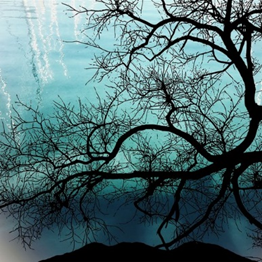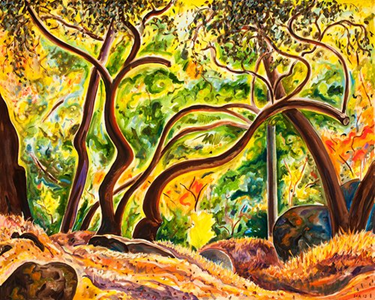I Love My Tree; My Tree Loves Me
- Malcolm Ryder
- Aug 14, 2024
- 5 min read
Updated: Aug 18, 2024
Gray Loft Gallery, August 2024
(Note: see the terrific thumbnail gallery of artworks in this show at grayloftgallery.com while reading this review…)
A real tree person doesn’t just see trees; and not even “the tree”… For a real tree person, it’s always my tree.
But when I show someone else my tree, there’s always a chance that they just aren’t going to “get it”.
What’s worse, the one thing all of us tree people begrudgingly know is that trees can do without us, yet we can hardly do without them. Far beyond curiosity, we’re in unrequited (?) pursuit of their love.
Well, it’s okay. The “love” we seek is usually inspiration – being inspired to have the tree’s grace, or dignity, or power, and some of its purity of innocence, along with the bonus of some kind of beauty. Something like that.
That’s why, although Gray Loft Gallery’s new show “Among The Trees” explores what a tree is “about”, the key word in its title is among – which makes the show about us.
What is it like to experience trees? What does that experience tell us about ourselves? And why does that realization so readily turn into a deep connection with them?
Of course, as an art show, that’s not only what the event explores. It’s just as much the case that curator Jan Watten’s sprawling selection of paintings, photographs, and mixed media examines how the artists variously get the artwork to express what they care about.
In that expression, there is a dialogue. On the one side: trees heightening our experience as being part of nature ourselves. And on the other side, the artists, using tree-like forms to mean something even when we are absent.
A Language of Nature
For all of the artists, “making a tree” involves the most abstract matter of representing something. What does something need to look like in order to get called a tree?
While any real tree, like a fingerprint, is unique in the specific arrangement of its details. But the images in this exhibit are by and large far less documentary than impressionist. They don’t want to explain the experience; they want to invoke it.
For some artists, creating an image of trees is about the most concrete act in visual art: making a mark. In this case, drawing the mark on a blank surface puts the artist in the exact position of the tree itself; the mark’s essential purpose is to branch outward from its beginning, and its underlying life force need explain its decisions to no one but itself.
But when portraying a tree, there is no single particular real-world instance of one that defines “tree” for all the others. An image that we invent from scratch as a “likeness” of a tree can have just as much psychic authority as would an exact copy of an actual tree. A few of the show pieces - an assemblage or mix of selected parts, as done by Lorrie Fink and Marsha Ballan - are literally object lessons in this. But then curiously, a photo by Tony Bellaver achingly projects the same thing in an opposite and literal way, by emphasizing what we feel is missing from what is shown, and known, as a tree.
The Substance of Style
While the variety of imagery in the show covers many different techniques and moods, those numerous distinctions don’t leave us thinking of the show as a big collection of different things. Instead, soon enough, we’re there thinking of a tree as one thing that has a tremendously imaginative range of ways to show up, when given half (or even less) a chance.
Still, there are a few rough groupings of work, distinguished as below by features which, however, some pieces also overlap or combine. That’s a good thing, like being served multiple flavors to work with in a fine meal.
About half of the show consists of works exploiting a distanced point of view, in which the spread of branches across the view is the subject matter. From those works, one thing that kept echoing in my mind was the famous phrase “architecture is frozen music.” Each such work is in effect a snapshot of a narrative, of something getting from one place to another. These highly gestural works hold a tension that comes from knowing that the displayed forms did not occur to be about us, yet we trace them especially to get a feeling, a feeling that we want to believe they also had. It’s as if to finally say that all trees dance.
On the other hand, there is Jen Cranes’ close study of single leaves and Cynthia Brannvall’s installed real branch segments. Superficially they have almost nothing in common with each other, but they both wind up offering experiences of the same thing: not distance, but intimacy. What comes from the closeness is a heightened awareness of how we ourselves are structured - a mix of free informality constrained by rigor. And although featuring just parts of a tree, these pieces give a distinctive idea of what, both as an experience and as an artifact, can be considered “complete”.
Regarding completeness, it’s interesting that very few of the works in the show had any strong interest in bark (!) Artistically, however, that is notable because of how much of the show’s work, without the additional detail, is more visually abstract. The abstraction functions to make the images more graphical. In turn, that makes some of them more directly gestural, and in that way more emotional; while in other images, it leaves more room for us to “fill in” our own predisposed emotions, adding them to the works as if we were busy making the pieces ourselves while looking.
Also, from that abstraction, we find works having trees with a monumental presence, their bold mass keeping them standing firm, beyond time. That can bring out our humility in knowing we are ourselves so impermanent, which is usually a strong feeling even if brief. But in most of these other works, we don’t get a mood from the tree. Instead, we find trees giving the work’s pictured space a mood, in a theatrical way. In effect, the artists have worked to elicit drama from the stillness of the trees.
And finally, in certain works, we find emphasis on the trees “giving life”, a crucial solace for our times, and due to the threat of losing them, one having political urgency.
On Your Walk
It seems unfair to pick out just two of the many fine pieces in this exhibit, and you’ll leave it with your own favorites, possibly many. But one of the most unusual of the works is a show-stopper hanging piece by Sarah Grew featuring dozens of transparent images suspended on wires, that together practically offer an index to all of the other works in the show. The best word to describe what this intensity conveyed to me is “passion”. And nearby to that is the largest wall work in the show, by Steven Andresen, which has a joy of execution all across its surface that feels like what we’d always want trees in their setting to be able to do for us.
“Among the Trees” runs August 3 – August 31, 2024, open by appointment any Friday, Saturday or Sunday.


















Comments